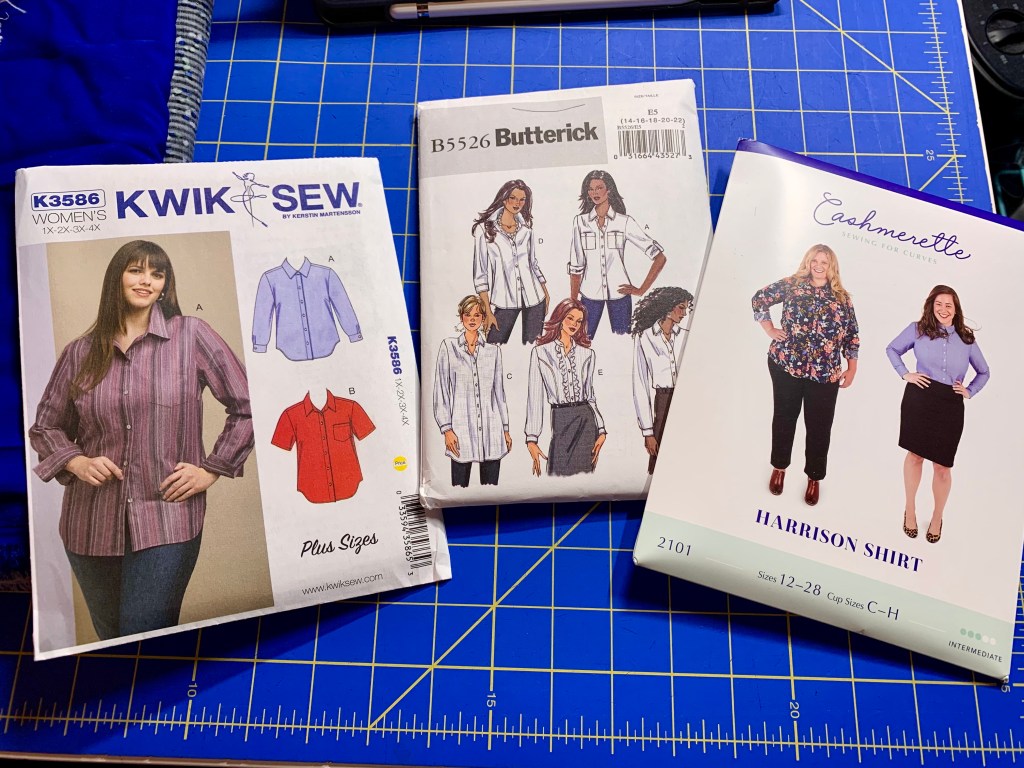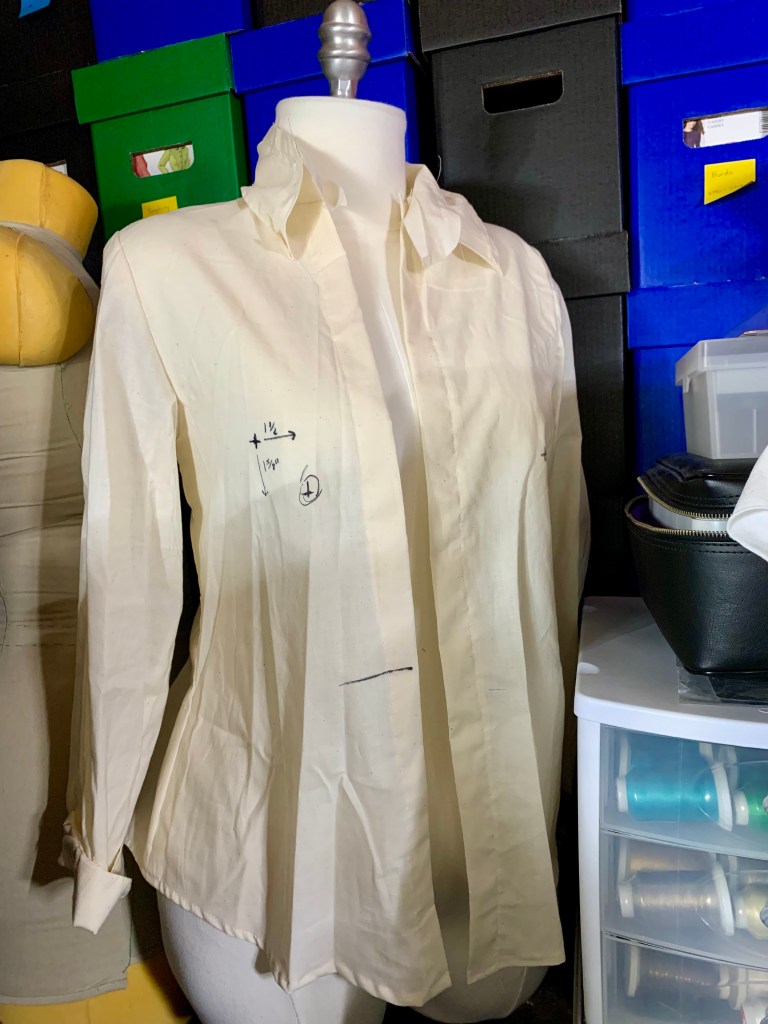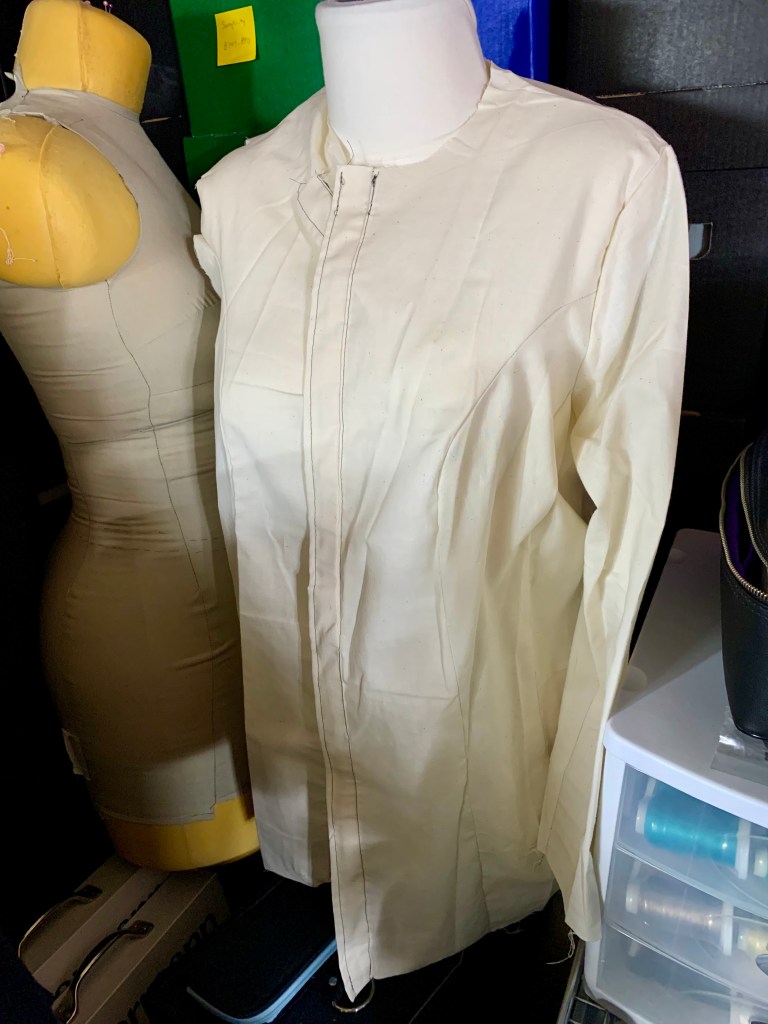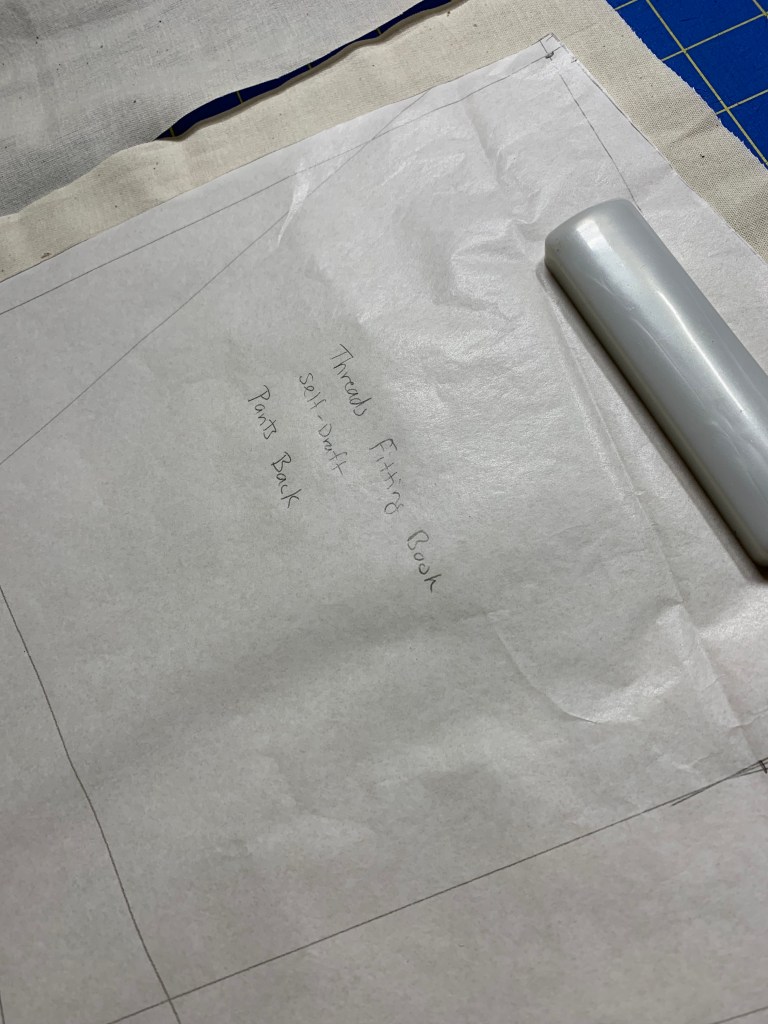Ok, so back at the beginning of September, I was naively hopeful that I’d complete my Micro-Mini Wardrobe sewing plans. But alas, for it was not to be. I was motivated and excited to work on all of those pieces, but I vastly underestimated the time it would take to fit new-to-me sewing patterns. Vastly. I’m not sure why. I’ve known for a long time that button-front shirts are the bane of my sewing existence. My track record of attempting to fit the darn things is, to put it mildly, pretty poor.

I started with attempting to fit Butterick 5525; it’s a pattern I’ve wanted to sew for a long time. Unfortunately, the first size I picked (size 14) was way too small. I knew I’d need an FBA and did one preemptively, but I couldn’t even get the collar to close around my neck, so clearly it was not even close to a good starting point. I then over-estimated the size I’d need and went with a 20; this was massively large, but not in a “cute and intentionally oversized” way. It was much more of a “it doesn’t fit well and looks sort of like a potato sack” kind of way. I suppose as an upside, I did get to practice some shirt-making techniques and explore the shirt collar and cuff placket making process before we get to any of the real fabric.
I was a bit dismayed by the fitting results from the Butterick pattern, and rather than tracing off yet another starting point, I thought maybe it would be better to start off with a pattern where I wouldn’t have to make as many adjustments (like massive FBAs) right off the bat. So I decided to try the Cashmerette Harrison shirt pattern. It has a lot of great reviews on Pattern Review, and most people seem to get along well with the Cashmerette patterns. I will say I did not need to make an FBA, which was nice, but I did have a lot of other fitting issues. The shoulders were definitely too long and too low, as well as much too sloped for me. And even though I’d downloaded the full bicep sleeve PDF pattern and used that as a starting point, it was still too tight on me. I hadn’t use the largest size, but it feels way more restrictive than I thought it should. So I went to town making a lot of pattern adjustments to the shoulder and sleeve area based on my first toile. I thought it would be an easy bit of tweaking on the second version, but it really didn’t go well. The shoulder seam is the appropriate length but the back of the arm is now cut much too far in. I still need to make yet another round of adjustments, but it’s a lot of problems around the shoulder and armscye, which could go very wrong very fast. Maybe I need to start off with a smaller size to begin with, but the collar fit seems right, so I don’t know. It’s possible I just don’t match a Cashmerette bodice fit very easily.
To take a break from the frustrations of the top project, I also started work on the trousers I was planning for the mini-wardrobe contest. I knew that I was definitely not the same size I had been the last time I attempted Burda pants, but since my PJ pants pattern still fits I figured I could get away with starting from my usual size and making a few small adjustments. I couldn’t.
I spent the better part of two weeks waffling back and forth between weather it made more sense to attempt to scrap the pattern altogether, try to morph the design details onto a different Burda Plus pants pattern, or just wing it in terms of the massive amount of inches and adjustments I needed around the hip area. It basically led to a lot of pondering and indecision while I tried to figure out how best to deal with my fitting woes on any of my sewing projects, and also led to a quick knit top to avoid the stress of the situation.

At a certain point I busted out all of the pattern fitting books I own to see if I could diagnose some of these issues. In one book it suggested something along the lines of “even when you get bigger, the bone structure of your shoulders doesn’t change shape” which basically helped me consider that for tops I really didn’t need to choose a larger starting size, just needed to consider how best to make the necessary fit adjustments where they were needed. In Burda this seems to hold true; whenever I start with a size 40 top and make generous fit adjustments to the rest of the pattern it seems to work out well. I don’t really have a “usual” size in Butterick patterns though; my starting size has always been very pattern dependent, so I probably just need to test out a few more sizes to find the best starting point.
While looking through the Threads Fitting for Every Figure for more help with my trouser issues, I noticed that they had instructions on how to draft a pants pattern from body measurements. I was feeling a bit lost after looking at a lot of YouTube videos discussing the math of the crotch curve, so I figured that doing a self-drafted pant couldn’t be a worse place to start off from than I already had with my much-too-small Burda draft. So I spent the better part of a weekend self-drafting a design that I then took the better part of a month to actually find the time to test out.
Happily, the pants draft fits really well especially for a first attempt. I’m currently in the phase of trying to add the Burda design features I wanted from the original pattern to the self-drafted pattern that actually fits. I’m still in the middle of this process, and will totally need to do yet another test-fit garment before I’m feeling ready to cut out good fabric, but at least I finally feel like I’m on the right track with at least one sewing project. With a bit of work and a bit of luck, hopefully I’ll have at least one new pair of pants before the end of the month.

In other news, this near-magical success of self-drafting a pants block has made me far more interested in drafting patterns from scratch than I had been before. I had seen a recommendation for Patternmaking for Fashion Design on another blog (I can’t remember where – sorry!) and since it was significantly less expensive than most college textbooks, I thought it would be worth a try. I just got my copy and haven’t followed any of the instructions from this book yet, but I’m hoping that this can help me expand the sewing options available but also have a deeper understanding of pattern drafting and pattern fit.
So after a month of work I don’t have a lot of sewing projects to share or any fun pictures for the blog, but I have at least been doing some sewing, which is good. And with a bit of tenacity, a bit of work, and a bit of luck, hopefully I’ll have some more progress to show soon.






Hang in there – it took me 4 years to get a good crotch pattern! And that’s not even a whole pair of pants. Now I can make a pair with a pretty good outcome in knits or wovens but I always use 1″ lengthwise seams on everything as knits and stretch wovens vary so much in “stretchability.”
I have had multiple shoulder surgeries so I am still working on a t-shirt pattern but getting closer – I may have to go to 2 separate pattern pieces for the front and a whole pattern for the back. Then blouses and jackets, I’ve learned to measure everything and choose my measurements from multiple pattern lines as I go. I generally also need to do an FBA – as Kenneth King says “it’s either too big, too small OR the wrong shape!” Good luck – you will be very happy when it is all done.
LikeLiked by 1 person
Thanks! I’m really happy with the pants draft so far… with any luck fabric cutting will happen soon and I’ll be able to work on construction for a first run on the pattern.
LikeLike
Congratulations on getting your pants block drafted! Toiles and drafting are a huge amount of work on top of actually sewing.
I can second the ‘shoulders not changing shape’ thing. I first put on and then lost quite a few inches on my waist and hips over the last decade, but I’ve stuck with the same bodice size throughout and it still seems to work.
LikeLiked by 1 person
Yeah; with Burda I’ve for sure noticed that for tops at least I need to stick with a 40 and it will fit my neck and shoulders well, but I have to add more room elsewhere and do a FBA now (I didn’t always have to before but I definitely have to now). I’m not sure how I will need to adjust or edit jacket and coat patterns yet, but I’m hoping it will be similar. Pants though… pants seem to be in their own special category of weird.
LikeLiked by 1 person
I’m very tempted to do the flexible ruler thing for getting the curve right on pants.
LikeLiked by 1 person
I have one and tried it! It seems to work pretty well if you only need to adjust the shape a little. In my case I needed to adjust a lot so drafting from scratch worked better. But I think if it’s just *where* the curves are and not *how much* curve you need then it can be helpful to visualize.
LikeLiked by 1 person
Thanks! Definitely another thing to try then
LikeLiked by 1 person
I must admit that I also have shoulder fitting problems, which I’ve been working on FOREVER. So I’ll continue to follow your journey. (O.K. I have the same shoulders, everything else got bigger, lolol…)
I’m impressed with your drafting your own pants block, and look forward to seeing how they turn out. Now I’m off to find my copy of “Threads Fitting for Every Figure” to see if I can find out about the “flexible ruler thing”… (etc.)!
LikeLiked by 1 person
Good luck! I think fitting is one of the most interesting parts of sewing but also the most annoying because it feels like you can spend so much time not getting the results you want. Hopefully I will find something that works and will have more to report back with soon!
LikeLike
I feel your pain. Fitting always takes me weeks to months. I am always gobsmacked when people can make something that fits out of the box. And changing designers is so frustrating because you pretty much have to start from scratch.
My body is far from average, even panty crotches don’t fit me. I tried drafting a top years ago, but the result was so peculiar, and certainly didn’t fit, I gave up on it as more trouble than adjusting a pattern. I will look at the drafting system you used, but don’t have as much trouble fitting bottoms as tops.
I know exactly what I need to do for Burda patterns (FBA, wide round back, forward shoulders, large bicep, shorten at waistline, scoop crotch, knock knees, and muscular thigh adjustment). Itch to Stitch I need FBA on their biggest cup, wide back, bicep and armhole changes. Greenstyle I need FBA and bicep, but strangely fewer adjustments than other designers. Only have one success so far in Cashmerette, since I found out I need to start with 6 G/H and do FBA, instead of 8 G/H, as well as wide back adjustment. On closer fitting sleeves their full bicep sleeve won’t be big enough either.
My blogposts on fitting different shapes use models to show how small differences cause problems. I find the ‘ideal types’ helpful for analysing what is going on.
Crotch fitting: Unmentionables: Crotch Variation in Pantie Fitting
https://thesewcialists.com/2021/05/14/allbuttswelcome-unmentionables-crotch-variation-in-pantie-fitting/
Crossover bust fitting: Causes and Cures for Wrap Bodice Gaping’
https://sewbusty.com/2021/07/15/community-blog-cross-your-heart-woes-causes-and-cures-for-wrap-bodice-gaping-with-karey/
LikeLiked by 1 person
Thanks for sharing those resources! I’ve read the first article before but I need to check out the second.
LikeLiked by 1 person
Fitting is a challenge! I feel like it is something that I have to relearn with every project. Good luck!
LikeLiked by 1 person
Thanks!
LikeLike
I have one of those crotch curve rulers and tried it against a Burda pattern and the Closet Case/Core Gingers… womp womp, my crotch is bog standard, apparently. I sometimes need adjustments in other parts of pants but not there. For shirts, though, I just wouldn’t expect one to fit unless it’s a pretty loose-fitting design. When I think of how many fitted RTW ones I had to try on before I was satisfied enough to buy something, I figure making that many toiles is fair! I also have that Patternmaking for Fashion Design book. I once opened it, shrieked, shut it and haven’t touched it since. Maybe in a few years I’ll work up the courage to try it again.
LikeLiked by 1 person
You’re an inspiration for all the work you put into these. I ALWAYS underestimate the difficulty and time involved
LikeLiked by 1 person
I spent quite a bit of time a few years back drafting and refining a pant block, and it is great to do this as its own project, not the first step you’re rushing through to get to the “real” sewing. I ended up with a good pattern I can pull out and sew a new pair of pants fairly quickly. I can now just add the design features from other patterns rather than starting from scratch each time. It doesn’t feel like you’re making anything when you’re developing your block, but it is really worthwhile!
LikeLiked by 1 person
Yes, I’m realizing that now! My first pants are going to be some basic-ish trousers, but I’m excited to see if this method can work for me for some more interesting designs in the future.
LikeLike
It so cheers me up to hear that other people are like me and spend much of their sewing time weeping and groaning over fit !
With all our different bodies, it seems that we each find something different opens the door to a solution. Using a bendy ruler for my very different crotch curve worked wonders for me. For tops I know my big focus needs to be on shoulder fit, while some fitting systems leave that to last.
LikeLiked by 1 person
Taking the pants drafting course on Craftsy with Suzy Furrer has changed my life. Having that sloper has been eye opening and has made pant fitting so much simpler. I am anxious to do her bodice drafting course now. I must make the time. Good luck with your plans. I think you will be so pleased to have a well-fitting pant sloper.
LikeLiked by 1 person
Oooh! Thanks for those recommendations! I’ll check those courses out! Especially the bodice draft because I don’t have a sloped for that yet.
LikeLike
Long ago I naively thought there was a standard way of drafting a sloper. . . No, there are many. Just to warn you -some people have great success but I have never found one that worked for me. I finally got a good bodice block in Brooks Ann Camper’s class – and what I finished with had nothing in common with what I had started from. But she’s not for everyone. Seems some of us can’t avoid putting in the work, both trying different methods and taking time over the ones that look promising. Good Luck !
LikeLiked by 1 person
Thanks! I think at least understanding more about drafting will be worth the time, and hopefully lead to more projects with less stress in the future.
LikeLike
Strangely I got a better fit when I shortened a shirt dress to dress length than I did from any ‘proper’ shirt patterns.
Burda is worth pursuing as they seem to be consistent in their sizing, plus there’s lots of back catalogue to pick from.
LikeLiked by 1 person
For years I also kept trying to find the right blouse pattern until I finally decided to make a basic blouse and then keep making it until I got it to fit. I used BS 2007-05-116, a basic fitted button-front shirt with horizontal and vertical darts. I traced it on tissue and tissue fitted it first. Then I made a muslin. After that each successive shirt was made wearable because you can tell so much better how something fits when you actually wear it. I won’t lie; I did a lot of basting and trying on in the process. Each new version was tweaked for a better fit. I made different sleeve lengths. I made different collars and one with a bias binding. I changed it up enough that it didn’t look like I had a whole wardrobe full of the same shirt. I think I made about 5 or so before I was totally happy. Now whenever I get a new shirt pattern I lay my basic pattern on top and I can tell a lot about what needs to be changed. I can tell about the dart placement, upper chest width, and the armscye height really quickly. I also wanted a yoked shirt so I bought Burda 6849 and altered it. I can’t tell you how awesome it is to have a woven shirts that are comfortable to wear!!!
I have gastroparesis and consequently have to deal a lot with weight change. My neck and shoulders never seems to change; I also require a 40 neck and shoulder in Burda. I usually carry my weight more back-to-front than side-to-side so all I generally need to do is to change width at the side seams of tops with weight change. I actually was quite surprised by that at first when you consider the way patterns are graded, but after thinking about it, it’s not like your shoulders are going to grow wider as you put on weight is it?
I did the same sort of thing with pants. I chose BS 2006-08-109 because it was a basic pants pattern with a shaped waistband (which I need). I overlay my pants pattern on new patterns and I can see almost immediately what needs altering. If you’ve gotten your pants the way you like them why don’t you try using it to alter other patterns. I realize that there are differing crotch shapes for jeans versus pants versus trousers, but I do find that using the fitted ones as a basic guideline has proved very helpful. I do find with pants though, that I also have to alter the crotch extension as well as the side seams with weight changes.
The one thing that helped me with fitting the most was to realize that fitting is just about adding fabric where it’s needed and removing it where it’s not. Not all alterations are going to be covered in a fitting book. One of the things that helped me the most I found on Robin Denning’s sewing blog years ago, so don’t expect your issues to necessarily be covered in the books. For me, it was well worth the investment of time to go through the process. The best part was that I learned exactly what alterations I need for Burda patterns; I can generally make the same alterations for each of theirs. The other pattern brands, NOT so much!
LikeLiked by 1 person
Thanks for sharing! This is really helpful for seeing how much effort goes into getting a perfect fit. I agree that Burda is the most consistent with sizing, and in my experience it is not the same way with other pattern brands. I’m hopeful that one I get to a good base pattern I’ll be able to use it in a similar way to adjust details for design interest.
LikeLike
It may not take you as many iterations as it did me. I have narrow, square, forward shoulders. I need a petite adjustment in the armhole (even though I’m average height). I always need a very small dart rotated out of the armhole, and I have to lower my bust dart. Learning all that took time and iterations, but you may be a lot easier to fit and it may not take you as long or as many garments as it did me. One thing I should have mentioned is that even small 1/4″ alterations can make a really big difference in fit. I learned a lot through the process and don’t regret a moment of the journey.
LikeLiked by 1 person
I feel your pain! Every time I make something using my bust measurement it is way too big at the shoulders. In my ignorance I thought I will just cut a bit out of the shoulder. Of course that made the armhole too big. Then I decided to do a narrow shoulder adjustment on the pattern. But armholes we’re still too big. Now I use the upper bust measurement or measure the shoulder seam to work out my size and then do a fba. This has been easier but has taken a lot of time. I finally made a nice white blouse but put the buttonholes too far over because I used the buttonhole template after I had sewn the pieces together. Ruined the whole look of the blouse. I have made another. Collar and cuffs done and joined to sleeves. I just need to put the collar on, add the sleeves and do the buttonholes but it has sat there for 2 months while I did other easy things. My attempts at pants have been failures but as I have completed a toile for a French jacket it will work my way down my body and hope to make a decent pair of pants before I die! Lol
LikeLiked by 1 person
Fitting can be such a drag, especially with a button-up shirt where there are so many moving parts. I admire your tenacity, 12 muslins is a lot of work! I know you love the old Burdas, nothing in there of interest?
FWIW, I highly, highly recommend the book “Fitting & Pattern Alteration: a multi-method approach”. It’s out of print and used copies aren’t cheap but it’s really worth it–it’s changed my fitting game completely. (I think it’s actually going to replace at least 2 fitting books in my collection, including Fit For Real People–it’s that good.)
LikeLiked by 1 person
Oooh, thanks, I’ll have to check it out! I might also try a Burda pattern… at this point I sort of want to play a “which brand fits best” game and test a button down shirt from like all of the major brands.
LikeLike
Sorry that Butterick pattern didn’t work for you. I had good luck with it.
LikeLiked by 1 person
I think it’s a good pattern, I just think I haven’t found the right starting point yet. I really like the style and the details are great. I just need to tweak the fit, which is a me thing, not a pattern issue.
LikeLike